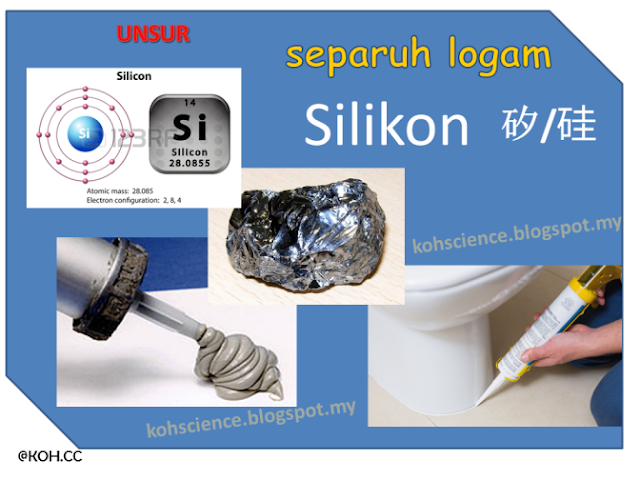KOMPILASI VIDEO SAINS PT3(T1-T3)
- Home
- about KOHSCIENCE
- YOUTUBE
- PBL- PEMBELAJARAN BERASASKAN PROJEK
- Tingkatan 1 BAB 1 (KSSM)
- Tingkatan 1 Bab 2 KSSM
- Tingkatan 1 Bab 3 KSSM
- Tingkatan 1 Bab 4 KSSM
- Tingkatan 1 Bab 5 KSSM
- Tingkatan 1 Bab 6 KSSM
- Tingkatan 1 Bab 7 KSSM
- Tingkatan 1 Bab 8 KSSM
- Tingkatan 1 Bab 9 KSSM
- Pembiakan Yis
- FB
- School Lab Malaysia 2017
- FROG
- i-think map
- Gambar
- Solar Cooking
- ILMU sains
- Science Web
- using computer/app
- Kohscience T2
- kohscience in Mandarin 华文版
- Google Classroom (for students)
- KOMPILASI VIDEO SAINS PT3(T1-T3)
- Latihan
Tingkatan 1
Sunday, 30 July 2017
Friday, 28 July 2017
Tuesday, 25 July 2017
Jadual Berkala
1. http://ed.ted.com/periodic-videos
2. http://elements.wlonk.com/ElementsTable.htm
3. https://www.webelements.com/
4. http://www.ptable.com/
5.
http://www.boredpanda.com/periodic-table-of-elements-character-design-kcd-studios/
6.http://www.lenntech.com/periodic/periodic-chart.htm
7. http://www.rsc.org/periodic-table
8. https://www.inorganicventures.com/periodic-table
9. https://www.iupac.org/cms/wp-content/uploads/2015/07/IUPAC_Periodic_Table-28Nov16.pdf
10. http://periodic.lanl.gov/index.shtml
11. http://kcvs.ca/isotopesmatter/iupacMaterials/javascript/Interactive%20Periodic%20Table%20of%20the%20Isotopes/HTML5/index.html
12.
http://www.chemicalelements.com/
13. https://periodicstats.com/
14. http://images-of-elements.com/
IUPAC released the most recent version of the periodic table on Nov. 28, 2016. It includes elements 113 (Nihonium – Nh), 115 (Moscovium – Mc), 117 (Tennessine – Ts), and 118 (Oganesson – Og).
Sunday, 9 July 2017
Wednesday, 5 July 2017
JIRIM
Saturday, 1 July 2017
How Long Does It Take To Ovulate?
How Long Does It Take To Ovulate?
A woman needs to ovulate each menstrual cycle in order to become pregnant. During a healthy menstrual cycle, a series of hormone secretions lead to the maturation of a dominant follicle in the ovary and release of an egg or ovum (ovulation) to meet a sperm for fertilization in the fallopian tube.
For a variety of reasons some women don’t know the events that need to happen for ovulation to occur, or when they ovulate each menstrual cycle, and many others suffer from ovulatory dysfunction or anovulation. Failure to ovulate is one of the primary causes of infertility.
|
女人需要每个月经周期的排卵才能怀孕。在一个健康的月经周期中,一系列的激素分泌会导致卵巢中一个显性卵泡的成熟,释放一个卵子或卵子(排卵)以满足精子在输卵管内受精的需要。
出于各种原因,一些女性不知道排卵事件,或者不知道几时是排卵期,还有许多人患排卵障碍或不排卵。不排卵是不孕的主要原因。
|
This video is an informative animated presentation that explains in detail about ovulation.
Ovulation is a part of the menstrual cycle when the ovary releases an egg or ovum.
Inside the ovary there are thousands of follicles. Each follicle is a hollow ball of cell with an immature egg in the center.
The typical 28-day menstrual cycle begins on the first day of the menstrual bleeding.
During the first seven days of the cycle, a few follicles begin to grow at the same time.
These maturing follicles secrete estrogen hormone into the bloodstream to prepare the lining of the uterus for pregnancy.
Around day 7, all of the follicle stop growing and begin to degenerate except for one, this dominant follicle continues to grow and nourishes the developing egg inside it.
Around day 12, the follicle secretes a large amount of estrogen into the bloodstream.
When the estrogen reaches the hypothalamus in the pituitary gland in the brain, the anterior or the fun part of the pituitary gland releases a huge surge of luteinizing hormone into the bloodstream.
Watch the video to know more in detail about Ovulation.
|
这个视频是一个内容丰富的动画演示,详细解释关于排卵。
当卵巢释放卵子或卵子时,排卵是月经周期的一部分。
卵巢内有数千个卵泡。每个卵泡都是一个中空的球状细胞,中间有一个未成熟的卵细胞。
典型的28天月经周期开始于月经来潮的第一天。在周期的前七天,一些卵泡同时开始生长。
这些成熟的卵泡分泌雌激素进入血液,为怀孕准备子宫内膜。
大约在第7天,所有的卵泡停止生长并开始退化,除了优势卵泡继续生长并滋养发育中的卵子。
大约在第12天,卵泡分泌大量的雌激素进入血流。
当雌激素到达脑下垂体中的下丘脑时,垂体前部会释放大量黄体生成素进入血流。
观看视频了解更多关于排卵的细节。
|
ovulation is a part of the menstrual cycle when the ovary releases a ripe egg
or ovum inside the ovary are hundreds of thousands of follicles each follicle is
a hollow ball of cells with an immature egg in the center the typical 28-day menstrual cycle begins on the first day of menstrual bleeding during the first seven days of the cycle a few follicles begin to grow at the same time these maturing follicles secrete estrogen hormone into the bloodstream to prepare the lining of the uterus for pregnancy around day seven all of the follicles stop growing and begin to degenerate except for one this dominant follicle continues to grow and nourishes the developing egg inside it around day 12 the follicle secretes a large amount of estrogen into the bloodstream when the estrogen reaches the hypothalamus and
the pituitary gland in the brain the anterior or front part of the pituitary gland releases a huge surge of luteinizing hormone into the bloodstream around day 14 luteinizing hormone causes
the follicle to undergo a sudden growth spurt right before ovulation the egg detaches from the inside of the follicle the bulging follicle releases chemicals causing one of the two fallopian tubes to move in closer and surround the follicle. the follicle swells until it bursts open ejecting the egg and fluid from the follicle into the abdominal cavity , in response the thin Bri a tiny projections at the end of the fallopian tube sweep across the ovulation site and pick up the egg microscopic cilia on the fem ba surface transport the egg to the entrance of the fallopian tube inside the walls of the fallopian tube muscular contractions gently push the egg towards the uterus after ovulation the egg lives for 12 to 24 hours so it must be fertilized by a sperm from the male during this time for a woman to become pregnant if it's not fertilized the egg dissolves away and is shed along with the uterine lining during menstruation
Subscribe to:
Comments (Atom)
































